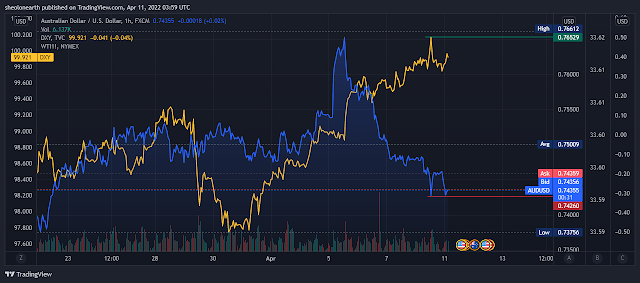Australian dollar collapses on Chinese inflation figures. Chinese 10YR Bond yield is falling beneath the U.S. 10YR, this has only happened three times in 12 years. Chinese labor and electricity costs are surging. COVID-19 2nd beatdown is sending China into widespread stagflation.
Chart 1
Chart 2
As noted in this post, that the Australian dollar (AUD) is overbought, with the Chinese PMI now showing a economy in contraction, the other factor that does not justify bids on the AUD is the yield differential between the the U.S cash rate and the Australian $ cash rate, which show's that the US dollar is more lucrative with a higher yield than the AUD. The final beatdown for the AUD was the recent Chinese Producer Price Index (PPI), with inflation now surging, coming at 8.3 % year-over-year. Chart.1 shows the AUD collapsing from the 6th April 2022 highs of 0.75 cents down to 0.74 (11/04/2022) on release of the Chinese inflation data. Note the price support at 0.742, which could be, speculatively, a central bank stabilizing support line. Either way, bids have supported the AUD above its 5 day lows. The white line comparison is the DXY (U.S. Dollar traded against a basket of currencies) that is now bid on stronger U.S. yields and expectations of a 50 basis point hike by the Federal Reserve in May 2022, which will probably end up being another 25% rise. Essentially, there are rate increases in small steps, making the U.S Central bank leading the charge over Europe and the U.K central banks, albeit slowly, to tackle inflation that just might go hyper, watch bread prices.
Chart 2 is further proof how dire the Chinese situation is, with the Chinese 10 YR bond yield falling beneath the U.S. 10 YR yield, this has only happened three times in 2006, 2010 and 2016, while briefly falling below in 2020 (COVID-19 pandemic). Which shows the impact on the economy via part 2 lockdowns in China as COVID-19 has returned with a vengeance , also note Chinese labor costs and Electricity production that are all surging since 2020. Which equates to the 2nd largest economy going into widespread stagflation.



Comments
Post a Comment